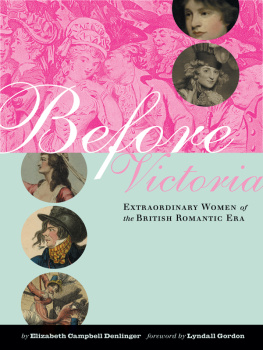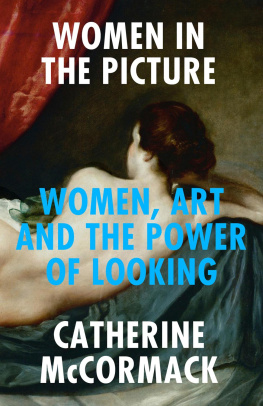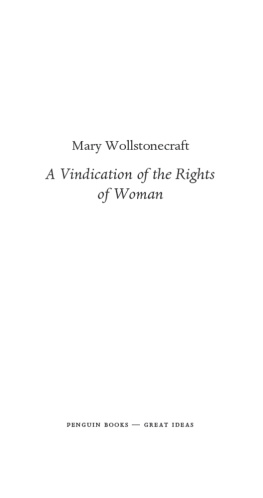Before Victoria
EXTRAORDINARY WOMEN of the BRITISH ROMANTIC ERA
Before Victoria
EXTRAORDINARY WOMEN of the BRITISH ROMANTIC ERA
by ELIZABETH CAMPBELL DENLINGER
Foreword by LYNDALL GORDON
The New York Public Library/Columbia University Press
New York
2005
Published on the occasion of the exhibition
Before Victoria: Extraordinary Women of the British Romantic Era
presented at The New York Public Library
Humanities and Social Sciences Library
D. Samuel and Jeane H. Gottesman Exhibition Hall
April 8July 30, 2005
This publication and the exhibition were made possible in part by The Carl and Lily Pforzheimer Foundation, Inc., and The New York Public Librarys Carl H. Pforzheimer Collection of Shelley and His Circle. Additional support for this publication was provided by Sue and Edgar Wachenheim III and by the Bertha and Isaac Liberman Foundation, Inc., in memory of Ruth and Seymour Klein. Support for The New York Public Librarys Exhibitions Program has been provided by Pinewood Foundation and by Sue and Edgar Wachenheim III. Illustrations are drawn from the following collections of The New York Public Librarys Humanities and Social Sciences Library: the Carl H. Pforzheimer Collection of Shelley and His Circle; the Miriam and Ira D. Wallach Division of Art, Prints and Photographs, Print Collection; the Henry W. and Albert A. Berg Collection of English and American Literature; the General Research Division; the Rare Books Division; and the Spencer Collection. Karen Van Westering
Manager, NYPL Publications
Anne Skillion Senior Editor
Barbara Bergeron Editor
Jennifer Woolf Photography Coordinator Designed by Kara Van Woerden 
www.nypl.org | Copyright 2005 by The New York Public Library, Astor, Lenox and Tilden Foundations E-ISBN 978-0-231-50993-0 The name The New York Public Library and the lion logo are registered marks and the property of The New York Public Library, Astor, Lenox and Tilden Foundations. Library of Congress Cataloging-in-Publication Data Denlinger, Elizabeth Campbell.
Before Victoria : extraordinary women of the British Romantic era / by Elizabeth Campbell Denlinger. p. cm. Published on the occasion of the exhibition, Before Victoria: extraordinary women of the British Romantic era, presented at the New York Public Library, Humanities and Social Sciences Library, D. Samuel and Jeane H. Gottesman Exhibition Hall, April 8July 30, 2005T.p. verso.
Includes bibliographical references (p.) and index. ISBN 0-231-13630-7 (Columbia University Press : alk. paper) ISBN 0-231-13631-5 (Columbia University Press : pbk. : alk. paper)
1. WomenGreat BritainBiography. 2. Great BritainHistory1789-1820Biography. 3. Great BritainHistory1800-1837Biography. 4. Great BritainSocial conditions18th century. 5. Great BritainSocial conditions19th century. 6. Great BritainBiography. I. New York Public Library. II. Title. cT3320.D46 2005 305.4094109034Dc22 2004059267 Columbia University Press
Publishers Since 1893
New York Chichester, West Sussex cup.columbia.edu www.columbia.edu/cu/cup CUP would be pleased to hear about your reading experience with this e-book at . |
CONTENTS
Who were the women in the late eighteen hundreds and early nineteen hundreds who set themselves apart from social expectations? Before Victoria, drawing primarily on The New York Public Librarys great Pforzheimer Collection, opens up the lives of an array of women who turned away from the beaten track during the fifty years before the rise of the Woman Question, the more familiar movement that took off during Victorias reign.
In 1787, two years before the French Revolution, Mary Wollstonecraft was a restless governess, reading Rousseau in an Irish castle and collecting matter for her first novel, Mary (1788). The soul of the author was to animate the hidden springs of a new kind of being called by her own name: in a fiction, such a being may be allowed to exist; not subjugated to opinion; but drawn by the individual from the original source.
Later that year she took the novel to London, determined to shed the limited occupations open to women. She meant to find a new plot of existence for her sex. I am going to be the first of a new genus, she confided to her sister Everina. I am not born to tread in the beaten trackthe peculiar bent of my nature pushes me on. When Mary in the novel rejects the practice of giving a bride in marriage, the author herself was germinating the new character who found fruition in A Vindication of the Rights of Woman (1792). Every phase of her life was an experiment: the school she set up in her twenties, her years in France during the Terror, her travels to Scandinavia, and her unconventional union with William Godwin, the foremost radical philosopher of the day. As we trace her experiments, above all that most fruitful experiment, her relation with Godwin, we see everywhere a single purpose: to center the affections as a counter to the twin predators of violence and commerce.
Her one-time pupil Margaret King Moore, Lady Mount Cashell also broke with womens traditions. In 1806 she abandoned her aristocratic life and disguised herself as a man in order to attend medical lectures at the University of Jena. She went on to practice medicine in Pisa (in the respectable guise of helping the poor), rejecting harsh and hopeless interventions as well as lucrative drugs, in favor of gentler cures, particularly with children, and better use of the bodys own curative powers. Mary Shelley, Wollstonecrafts daughter, earned her living as a writer, most famously as author of Frankenstein. Her stepsister, Claire Clairmont, played the overture to Rossinis new opera Cenerentola, and her voice, trained to performers standard, thrilled their Pisa circle in one of Shelleys greatest poems, To Constantia, Singing. After Shelleys death, Clairmont supported herself as a governess in what she called my ice caveRussiawhere she developed
Wollstonecrafts innovative ideas of education, and wrote letters yet to be recognized as among the best in the English language. The achievements of this generation were all the braver in the context of counterrevolution, its silencing of women and their obligatory retreat from the public arena.
There were others, like the novelist Mary Hays, who tried out the character Wollstonecraft had brought into being. The future poet Elizabeth Barrett was only twelve in 1818 when she read the Rights of Woman. At fourteen she would declare her natural independence of mind and spurn the triviality of womens lives. Similarly, in 1825, a daughter of a New England clergyman published her thoughts on The Natural Rights of Woman. The Creator, she argues, crowned his labors by giving being to the most intelligent of his creatures:
Male and female created he them; but declared them of one boneone fleshone mind. To them he directed his divine commandsand gave them rule over all he had made.
But it seems that man soon became wiser than his Maker, and discovered that the Almighty was mistaken and that all the mind had been bestowed on himself, and that woman had received only the mere leavings, and scrapings that could be gathered after his own wise brain was furnished.
Twelve years before the founding of Mount Holyoke, the first womens college, the author is hopeful of the schoolhouse with its custom of equal education, and fewer inducements to phoniness. To be sure, girls still leave with nothing more than a smattering of
Next page






